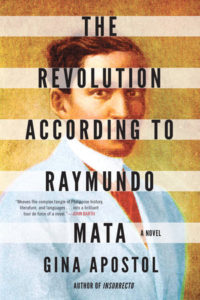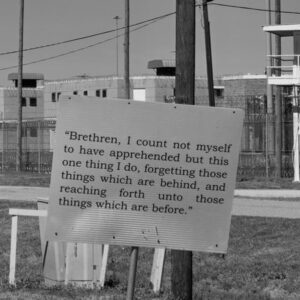
No Failure of Imagination: Gina Apostol on Revolution, Illusion, and Translation
Sabina Murray Talks to the Author of The Revolution According to Raymundo Mata
Photo credit JL Javier.
Gina Apostol’s latest novel The Revolution According to Raymundo Mata—which won the Juan Laya Prize for the Novel (Philippine National Book Award)—is a marvel of structure, history, voice, and humor. Remarked on for its narrative complexity, Raymundo Mata may at first seem dense, but it is not, rather to be savored—like foie gras—a bit at a time. This rich comedy grows out of a tradition launched by Borges, an influence readily acknowledged (a Pedro Ménårdsz pops up in the footnotes), but also calls to mind the rollicking humor of Flann O’Brien’s At Swim-Two-Birds in its textual meddling, using the disruption of order as an organizing principle.
In fact, the book can be seen as an exploration of the comic: the compulsive punning of the Filipino, the wry conceits of the critic, Apostol’s joyful wit in the deployment of a stunning array of the figures of speech. At its core, the book examines the bloody revolution that wrenched the Philippines from the stranglehold of Spain, only to thrust the nation into the rapacious embrace of the United States. First published in the Philippines in 2009, Apostol took advantage of this new American edition to further explore its themes of insurrection, media falsehood, and the splintering of reality under the force of differing opinion as she lived in Trump’s America. Raymundo Mata, despite its focus on an invented Filipino hero, should be required reading as we navigate these times.
*
Sabina Murray: Given recent events, I’m interested to know how you perceive the difference between insurrection and revolution?
Gina Apostol: I’ll answer this in terms of the history my novel deals with: the Philippine revolution against Spain and America was a movement to free Filipinos from colonizers and invaders—it was about freedom, sovereignty—“ang mga kara[m]patan ng tao,” so Rizal translated the French Revolution’s 1789 Declaration of the Rights of Man, word for word, in a document found among his effects after Spaniards killed him, for his novels, in 1896. The revolution was grounded on the moral weight of “natural rights.”
I think Black Lives Matter, for instance, has a similar weight—one cannot argue Breonna Taylor’s right to sleep in her home without invasion and murder by police. One cannot argue George Floyd’s right not to be murdered because of a grocery transaction. Filipinos were revolutionaries trying to change society that did not see them as fully human—their anti-colonial war asserted that primal sense of right and thus an overturning of an unjust order. But when in 1899 the Philippine-American war broke out, Filipinos were called insurrectos by Americans who used the language of its former enemy Spain—that is, to the American colonizer, Filipino revolutionaries had no right, were going against an established order (of course, to which Filipinos had not consented), and so the US committed genocide on a people. The US colonized the Philippines via the illusion of being a shining city on a hill, “benevolent assimilation,” but it was, in fact, savage thuggery that girded the imperial project.
SM: And this concept of “natural rights” does not extend to those who invaded the Capitol on January 6?
GA: For me, today, those who stormed the Capitol are, in fact, insurrectionists. They are not revolutionaries. They are going against an established order, but not out of natural rights but because they’re malignant crybabies. No one has a natural right to have the president or dumb hat that they desire. To be honest, in my view, they are against Black Lives’ natural rights. For me, watching the riots, the abiding animus is against BLM, and the natural rights of people they hate for no good reason—Jews, for instance. That anti-natural rights animus, for me, is apparent even in the policemen’s acts—those that opened the barricades to the insurrectionists but tear-gassed the black lives protesters.
Filipinos were revolutionaries trying to change society that did not see them as fully human—their anti-colonial war asserted that primal sense of right and thus an overturning of an unjust order.
These rioters claim they’re an echo of 1776, once again referring to the illusion of the city on the hill (which was a speech from 1630, to be clear—right at the doorstep of US’s history of genocide). But those rioters are in fact echoes of old thuggery that accompanies that illusion—the thuggery imposed on Native Americans, blacks, and the people America has colonized and occupied domestically and around the world. For me, what we see as our nation—the shining city or, in the case of the Philippines, the nation of Rizal—is in fact illusions that have constructed us. We are usually blind to our nation’s contingency and textuality and historicity—but I think the dominant, hegemonic nation is blinder than most to the horror of its illusions.
SM: Your views on imperialism, colonialism, and subjugation are well-reasoned, clear, but as a writer who approaches political subject matter—as I do in my own work—one has to use characters to act out these truths. How does the empathic mode—the writer occupying specific consciousnesses—of fiction complicate this in your work?
GA: Maybe for me structure is as important as characters. What I have been trying to do in my novels, maybe, is to figure out how to convey through my structural choices what I feel is true about humans—that we are constructed by illusions—but that doesn’t mean we should not strive for the better illusions: the ones that allow others, and not just ourselves, to be free. America has those better illusions but often fails to read itself through its thuggish ones. It has lived too long as a racist mob boss cloaked in its dreams as democracy’s savior. And so it surprises itself once again today by being a dumb blind country with no metacognition.
Our job is to choose our better illusions. The empathic mode of fiction perhaps allows us to occupy the enemy and for the enemy to occupy the other, and so on. These fictive occupations are transparent, maybe, in the doublings (and maybe triplings and quadruplings) in my novels—e.g., the wranglings of the critics in Raymundo Mata, which allow both us readers and the characters, too, to occupy the nationalist and the psychoanalyst and the translator as each weaves her illusions. But in my novels, through art, I hope that the reader consider the better illusions, the ones that, maybe, free us from ourselves, and see the other better. That’s why my novels always believe in books, even as they subvert the book’s stability.
SM: One could say that fiction acts as a translation of reality, a form that traffics in illusions given the patina of reality. But in a more specific mode, what does translation mean to you as a writer? What does translation mean in the context of colonialism? Or in the context of revolution?
GA: I grew up multilingual in the Philippines, and the weird ways of language have always been my toys—source of mystery and endless puzzling and joy, to be honest. In the context of colonialism, one’s translated self becomes simply an existential matter. It’s how one exists, along with whatever lurking psychic trauma goes on with that. In the context of revolution, I guess the job is to interrogate what translation has wrought upon you, in terms of power, politics, hierarchies, hegemonies. So my novels speak to all of those aspects of language and translation—joy and mystery, existential angst and psychoanalytic dread, and interrogation of power. I think entwining those things in art has been, mostly, kind of fun.
SM: And there is a tremendous sense of fun in Raymundo Mata, in having the characters and commentators in the book act out those various aspects, often in disagreement with each other. Raymundo Mata is a willful exercise in unreliable narration. What is the value of undermining this story, in particular as it purports to have historical value?
GA: Great question! What many of my novels have been doing right now is create texts in construction—my sense of reality being that we are selves being constructed by others, e.g., by the illusions and delusions and readings of others. So the act of reading is important in my novels, and the text-in-construction is an emblem of my sense of reality. I will say this—it is also hugely pleasurable to write about texts, about reading. It’s like chocolate, like glugging really good wine and going, whee, whee, such fun. Ha ha. Very often, of course, that kind of story rests on the unreliable narrator—in Raymundo Mata’s case, absurdly, nuttily unreliable.
I grew up multilingual in the Philippines, and the weird ways of language have always been my toys—source of mystery and endless puzzling and joy, to be honest
The absurd, crazy unreliable narrators in Raymundo Mata allow us, maybe, to think about how we read—the unreliable is also a metacognitive ploy that perhaps allows the reader to step back and consider her own ways of reading. So it is not an undermining of a story, for me—it is making transparent how we make and read stories. The fact that history is a constructed story, not an object in the world like a rock or a tree, is a truth important for all citizens in any country.
SM: Which must have been both inspiring and challenging as you were revamping Raymundo Mata during some turbulent times.
GA: Yes. I had this huge anxiety when I was revising Raymundo Mata for Soho—I was revising during the Trump era, you know. The text-in-construction gambit in my novel is not the same as “fake news,” but the question of the unstable text gave me agita. I had to be very clear about my concept of truth in this novel—because while the unreliable narrator allows us to recognize the constructedness of texts, this does not make facts relative. Facts exist, the body exists—and my novel actually rests, weirdly enough, on heavily researched material, as you can imagine. My novel is an album of facts wrought in illusion.
SM: I’m curious. How do you think this exploration of “facts wrought in illusion” reflects on the current state of media bias? What statement does this make about fake news?
GA: What “fake news” posits is that stories that don’t fit the narrative you want are not true. The Trumpists decrying “fake news” in fact dangerously align with what I’m saying about history as a constructed story—“fake news” recognizes the constructedness of narrative. But those who follow Trump’s constructions of other stories as “fake news” are not able to see how they, Trumpists, are being constructed, at the same time. That is—they lack metacognition. They don’t take the necessary step back to see how they are reading and are being read. Hence, shit happens—in a way, the dumb insurrection comes from their lethal bad readings, and so they were used by someone else’s power interests. They’re abject texts within another’s bad-faith text. So for me, reading novels like mine allows readers to engage in a very healthy practice—the unreliable text makes transparent a truth, that history is constructed and contingent, allows us to practice metacognitive reading, where we question how we know what we know, how to interrogate authorship, and how to choose, I hope, the better illusion for the nation. And then after reading my novel, you go and dig up what is fact and not fact, and that digging can also be fun.
SM: Footnotes in Raymundo Mata become more than addenda. One wonders whether the ostensible main narrative or the footnotes is the dominant form in this novel. How do you see this commenting on the way we read now?
GA: I always read the comments in articles that interest me. Do you do that? I like to read the fighting that goes on in comments sections. I mean, I’m a novelist—all commenters are grist for the mill, as John Barth used to say—the people in comments sections are characters who add to my research on humanity. Also on Twitter now there’s this intriguing reversal—this genre of subtweets—posts that are annotations of another that become the main text on someone else’s page. I began Raymundo Mata in 1998, and I chose this footnoted structure in earnest around 2005. It came from my sense of Philippine history being so intriguingly contested—I mean, the text-hoaxes and the klepto scandals and the hugely personal historian-jousts—the contested notions of nation that are particularly passionate in a country that is also, at the same time, inventing itself—they were exciting, and hugely entertaining, and illuminating also about concepts of history and truth.
SM: In a way, the turbulence of the Philippine’s past and your recognition of contested history gives you an edge in understanding the way interactions with the media and proliferations of commentary create altered, or even new, narratives.
GA: Sure. Rereading Raymundo Mata now—in which the paratext can subsume the main story in this novel—I do find it interesting that it also anticipates the inversion of texts on the interwebzz. Twitter is actually a paratext, you know—tweets, subtweets, comments, retweets are all pointing toward some main text. An inversion of texts has happened, it seems—in which the paratext (the opinions, the annotations, the commenting) has become the center. But what is the main text? I do think it is a new medieval age. We are in a kind of neo-medievalism—with memes and visual posts subbing for stained glass in Gothic churches. An extreme subjectivity—the orthodoxy of the subjective—is now our norm. Where opinion is the truth, and science is now burnable on a cross. And then there’s the absolutely medieval shit of QAnon—no huge difference really from beliefs in the Middle Ages about blood libel—that Jews killed Christian babies, drained their blood, etc in a conspiracy against Christianity etc etc.
SM: But with all this paratextual inversion, the book is still, somehow, inspired and informed by the work of Rizal.
GA: In my novel, the centering of subjective commentary was, in my view, an aspect of love—love for a writer’s words. That is the ethical value of Rizal, in my novel. Its focus on Rizal, a writer and an artist, is about respect, and endearing and enduring love, for words. Whereas the medieval commentary we are seeing now—so much of it is being used for hate and power. Our main text should be love, and our paratexts should be how to honor it, how to give it. My novel is about my love for Rizal. We need to be a lot more reflective about how we are engendering paratexts—and why.
SM: In a Washington Post in an article on the storming of the Capitol, Monica Hesse asks “Was this a mob of domestic terrorists, or a confederacy of clowns?.” The sharp absurdism of this Raymundo Mata—and of other Filipino writers, such as Nick Joaquin—recalls that of Dostoyevsky, Bulgakov, and others. Why is now an important time to explore the conscious, articulate absurd?
GA: I’d say Filipino writers, from Rizal to Nick Joaquin to Ding Nolledo and Eric Gamalinda to Hagedorn and Elaine Castillo and Kristine Ong Muslim and, of course, your own work, Sabina, are very aware of the peculiar—you know Filipinos are generally writing from the space of their unknowability. It is hard to explain fully that weird feeling Filipinos have of being always both outsider and insider—for instance, owning and mastering the foreigner’s language and keeping your own secret (I think even the Fil-Am who does not speak a Filipino language understands that she keeps the secret of her mother’s language in her, like an amulet; and Filipinos who write in Tagalog are likely learned in the other language, too).
Reading novels like mine allows readers to practice metacognitive reading, where we question how we know what we know, how to interrogate authorship, and how to choose, I hope, the better illusion for the nation.
And in general we just experience our doubleness as normal—we make no fuss about it. It’s just us. So absurdism is bred into our ways of narration, I’d say. Are we surprised at characters who are both terrorist and clown? We have that guy in the presidential palace, hello. Are we surprised that those terrorist clowns are in the US Capitol? We’re a nation born into that US racist savagery, hello. I like Gogol a lot—Dostoyevski, Gogol, Nikolai Leskov’s Lady Macbeth—shit like that. I think you’re right that we have the weird peasant/revolutionist + urbanist/nihilist in our bones. There’s a great filmmaker, Lav Diaz, who does these seven-hour epics of Tolstoy and Dostoyevski set in Ilocos or Caloocan, and truly, the characters fit right in. We drink Dostoyevski like milk. Or maybe Ovaltine, ha ha.
SM: That’s absolutely true. The doubling and tripling you experience as a speaker of Waray, Tagalog, and English (among other proliferations, including places you call home) is analogous to the doubling that I—as a mixed-race Filipino/American, whose cultural makeup is heavily indebted to my Filipino roots, also feel. It is as if we can exist in two rooms simultaneously. And living in a state that is constantly weird does immure one to being shocked by other weirdness, or the absurd. To me, the most Absurd element of your book (absurd with a capital A!) is that we never see Mata’s memoir—which is a bundle of loose papers in no particular order—just a hash of its translation. Do you see the eponymous memoir in its entirety? As a speaker of Waray, Tagalog, and English, with some Spanish, does Raymundo Mata’s memoir exist as a book in your consciousness, or just as a united, forking thought system? Given these possibilities, do you have a working definition for “novel?”
GA: Hah. Finally someone talks about that. A huge McGuffin in this novel is that a gap is set up right before your eyes, a novel-length lacuna. I love that you’re setting up this gap around the definition of a novel. My working definition for novel would be that it is a thing we don’t know. And from that not-knowing we create something. And I think that not-knowing and creating is true for both the reader and the writer. There’s something about the novel that’s like an organism—every day we are just kind of siting there willing that yet-unknown thing to live. I always know the endings of my novels. I don’t know how I’ll get there. (And my imagined endings are pretty febrile, or just wisps—like a carousel going around and around in Gun Dealer, or karaoke at the end of Insurrecto—I had those in mind, from the start—why or how, I have no clue).
I also have a structure in my head, usually geometric—like Gun Dealer was a circle, and Insurrecto was a weave, like a mat weave. But I actually don’t know, when I am writing, how those things will work. I work by intuition, and not in any magical sense. I’d describe it as listening—listening to the text and what it seems to need, with a dim end in mind. For me, Raymundo Mata and everything about him exists—absolutely. If I thought I needed to put in the actual text of the memoir in the novel, I believe I’d make the effort. But for so much of us, it is the hologram of our dream that counts—that’s most real, somehow.
SM: Which in a way, comments on the construction of national identity. This is something that the United States is grappling with, intrinsic to the sense of democracy as “the great experiment.” A lot of the acceptance of this upheaval comes from understanding the different dreams that make the fabric of American identity, the fact that individual’s “holograms of dreams” are often the relevant reality. Given all this, what do you think America can learn from the Philippines historically, particularly in the current moment?
GA: America can learn that it has erected corrosive holograms of its fake exceptionalisms on countries like the Philippines, and now its racist-thug history is biting it in its butt. It should embrace the revolutionary history of people like the Filipinos and free itself from its own bondage to its bad illusions by borrowing our more loving historical radicalism, the radicalism that abides in Raymundo Mata—a radicalism that, in some ways, began with a novel, with an artist trying to will an organism, a text, into being, and then weirdly and absurdly and miraculously creating a nation. America should understand it is contingent, not necessary. It should see itself more like the contingent surprises in a novel’s creation—and so maybe somehow read itself better. Such modesty would be good for the world.
__________________________________

The Revolution According to Raymundo Mata by Gina Apostol is available now via Soho Press.
Sabina Murray
Sabina Murray grew up in Australia and the Philippines and is currently a member of the MFA faculty at the University of Massachusetts, Amherst. She is the author of Valiant Gentlemen, Tales of the New World, A Carnivore's Inquiry, Forgery, and The Caprices, which won the PEN/Faulkner Award for Fiction, and Slow Burn. Her new novel The Human Zoo is forthcoming from Grove Atlantic in August 2021.












